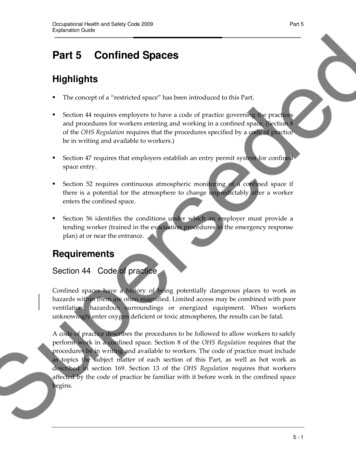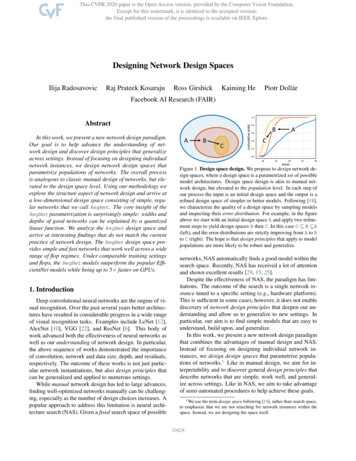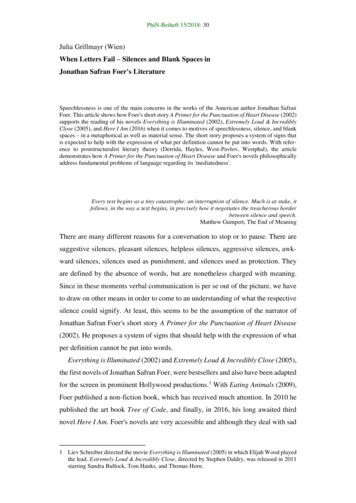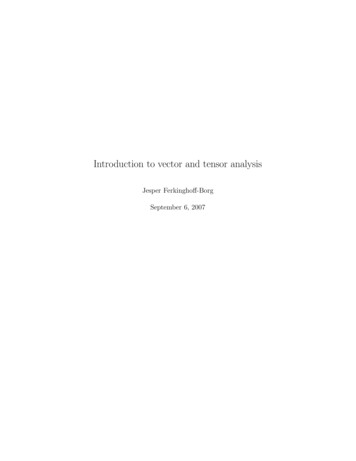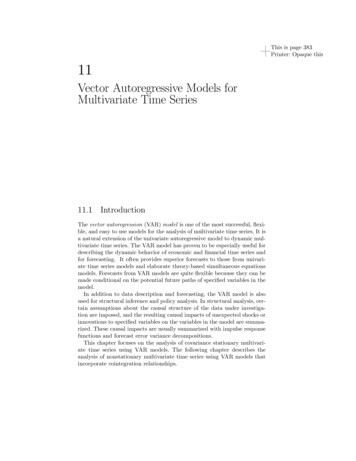
Transcription
San Francisco State UniversityDepartment of Physics and AstronomyAugust 6, 2015Vector Spaces in PhysicsNotesforPh 385: Introduction toTheoretical Physics IR. Bland
TABLE OF CONTENTSChapter I. VectorsA. The displacement vector.B. Vector addition.C. Vector products.1. The scalar product.2. The vector product.D. Vectors in terms of components.E. Algebraic properties of vectors.1. Equality.2. Vector Addition.3. Multiplication of a vector by a scalar.4. The zero vector.5. The negative of a vector.6. Subtraction of vectors.7. Algebraic properties of vector addition.F. Properties of a vector space.G. Metric spaces and the scalar product.1. The scalar product.2. Definition of a metric space.H. The vector product.I. Dimensionality of a vector space and linear independence.J. Components in a rotated coordinate system.K. Other vector quantities.Chapter 2. The special symbols ij and ijk, the Einstein summationconvention, and some group theory.A. The Kronecker delta symbol, ijB. The Einstein summation convention.C. The Levi-Civita totally antisymmetric tensor.Groups.The permutation group.The Levi-Civita symbol.D. The cross Product.E. The triple scalar product.F. The triple vector product.The epsilon killer.Chapter 3. Linear equations and matrices.A. Linear independence of vectors.B. Definition of a matrix.C. The transpose of a matrix.D. The trace of a matrix.E. Addition of matrices and multiplication of a matrix by a scalar.F. Matrix multiplication.G. Properties of matrix multiplication.H. The unit matrixI. Square matrices as members of a group.ii
J. The determinant of a square matrix.K. The 3x3 determinant expressed as a triple scalar product.L. Other properties of determinantsProduct lawTranspose lawInterchanging columns or rowsEqual rows or columnsM. Cramer's rule for simultaneous linear equations.N. Condition for linear dependence.O. Eigenvectors and eigenvaluesChapter 4. Practical examplesA. Simple harmonic motion - a reviewB. Coupled oscillations - masses and springs.A system of two masses.Three interconnected masses.Systems of many coupled masses.C. The triple pendulumChapter 5. The inverse; numerical methodsA. The inverse of a square matrix.Definition of the inverse.Use of the inverse to solve matrix equations.The inverse matrix by the method of cofactors.B. Time required for numerical calculations.C. The Gauss-Jordan method for solving simultaneous linear equations.D. The Gauss-Jordan method for inverting a matrix.Chapter 6. Rotations and tensorsA. Rotation of axes.B. Some properties of rotation matrices.OrthogonalityDeterminantC. The rotation group.D. TensorsE. Coordinate transformation of an operator on a vector space.F. The conductivity tensor.G. The inertia tensor.Chapter 6a. Space-time four-vectors.A.B.C.D.E.F.G.The origins of special relativity.Four-vectors and invariant proper time.The Lorentz transformation.Space-time events.The time dilation.The Lorentz contraction.The Maxwell field tensor.iii
Chapter 7. The Wave EquationA. Qualitative properties of waves on a string.B. The wave equation.Partial derivatives.Wave velocity.C. Sinusoidal solutions.D. General traveling-wave solutions.E. Energy carried by waves on a string.Kinetic energy.Potential energy.F. The superposition principle.G. Group and phase velocity.Chapter 8. Standing Waves on a StringA. Boundary Conditions and Initial ConditionsString fixed at a boundary.Boundary between two different strings.B. Standing waves on a string.Chapter 9. Fourier SeriesA. The Fourier sine series.The general solution.Initial conditions.Orthogonality.Completeness.B. The Fourier sine-cosine Series.Odd and even functions.Periodic functions in time.C. The exponential Fourier series.Chapter 10. Fourier Transforms and the Dirac Delta FunctionA. The Fourier transform.B. The Dirac delta function (x).The rectangular delta function.The Gaussian delta function.Properties of the delta function.C. Application of the Dirac delta function to Fourier transforms.Basis states.Functions of position x.D. Relation to quantum mechanics.Chapter 11. Maxwell's Equations in Special RelativityAppendix A. Useful mathematical facts and formulae.A. Complex numbers.B. Some integrals and identitiesC. The small-angle approximation.D. Mathematical logical symbols.Appendix B. Using the P&A Computer System1. Logging on.2. Running MatLab, Mathematica and IDL.3. Mathematica.iv
Appendix C. Mathematica1. Calculation of the vector sum using Mathematica.2. Matrix operations in Mathematica3. Speed test for Mathematica.Referencesv
Vector Spaces in Physics8/6/2015Chapter 1. VectorsWe are all familiar with the distinction between things which have a direction and thosewhich don't. The velocity of the wind (see figure 1.1) is a classical example of a vectorFigure 1-1. Where is the vector?quantity. There are many more of interest in physics, and in this and subsequent chapterswe will try to exhibit the fundamental properties of vectors.Vectors are intimately related to the very nature of space. Euclidian geometry (planeand spherical geometry) was an early way of describing space. All the basic concepts ofEuclidian geometry can be expressed in terms of angles and distances. A more recentdevelopment in describing space was the introduction by Descartes of coordinates alongthree orthogonal axes. The modern use of Cartesian vectors provides the mathematicalbasis for much of physics.A. The Displacement VectorThe preceding discussion did not lead to a definition of a vector. But you can convinceyourself that all of the things we think of as vectors can be related to a single fundamentalquantity, the vector r representing the displacement from one point in space to another.Assuming we know how to measure distances and angles, we can define a displacementvector (in two dimensions) in terms of a distance (its magnitude), and an angle: displacement from r12 (1-1) point 1 to point 2 distance, angle measured counterclockwise from due East (See figure 1.2.) Note that to a given pair of points corresponds a unique displacement,but a given displacement can link many different pairs of points. Thus the fundamentaldefinition of a displacement gives just its magnitude and angle.We will use the definition above to discuss certain properties of vectors from a strictlygeometrical point of view. Later we will adopt the coordinate representation of vectorsfor a more general and somewhat more abstract discussion of vectors.1-1
Vector Spaces in Physics8/6/2015distance rpoint2angleeastpoint1Figure 1-2. A vector, specified by giving a distance and an angle.B. Vector AdditionA quantity related to the displacement vector is the position vector for a point.Positions are not absolute – they must be measured relative to a reference point. If wecall this point O (the "origin"), then the position vector for point P can be defined asfollows:rP displacement from point O to point P (1-2)It seems reasonable that the displacement from point 1 to point 2 should be expressed interms of the position vectors for 1 and 2. We are be tempted to write (1-3) r12 r2 r1A "difference law" like this is certainly valid for temperatures, or even for distances alonga road, if 1 and 2 are two points on the road. But what does subtraction mean forvectors? Do you subtract the lengths and angles, or what? When are two vectors equal?In order to answer these questions we need to systematically develop the algebraicproperties of vectors. We will let A , B , C , etc. represent vectors. For the moment, the only vectorquantities we have defined are displacements in space. Other vector quantities which wewill define later will obey the same rules.Definition of Vector Addition. The sum of two vector displacements can be defined soas to agree with our intuitive notions of displacements in space. We will define the sumof two displacements as the single displacement which has the same effect as carrying outthe two individual displacements, one after the other. To use this definition, we need tobe able to calculate the magnitude and angle of the sum vector. This is straightforwardusing the laws of plane geometry. (The laws of geometry become more complicated inthree dimensions, where the coordinate representation is more convenient.) Let A and B be two displacement vectors, each defined by giving its length and angle: A ( A, A ),(1-4) B ( B, B ).1-2
Vector Spaces in Physics8/6/2015Here we follow the convention of using the quantity A (without an arrow over it) to represent the magnitude of A ; and, as stated above, angles are measuredcounterclockwise from the easterly direction. Now imagine points 1, 2, and 3 such that A represents the displacement from 1 to 2, and B represents the displacement from 2 to3. This is illustrated in figure 1-3. B A3 B2 A1 Figure 1-3. Successive displacements A and B . Definition: The sum of two given displacements A and B is the third displacement C which has the same effect as making displacements A and B in succession. It is clear that the sum C exists, and we know how to find it. An example is shown in figure 1-4 with two given vectors A and B and their sum C . It is fairly clear that the length and angle of C can be determined (using trigonometry), since for the triangle 1-23, two sides and the included angle are known. The example below illustrates thiscalculation. Example: Let A and B be the two vectors shown in figure 1-4: A (10 m, 48 ), B (14 m, 20 ). Determine the magnitude and angle from due east of their sum C , where C A B . The angle opposite side C can be calculated asshown in figure 1-4; the result is that 2 152 . Then the length of side C can becalculated from the law of1-3
Vector Spaces in Physics8/6/2015 C A B A20 1 48 348 2 C 210 m3B14 m248 -20 28 320 180 -28 152 C11Figure 1-4. Example of vector addition. Each vector's direction is measured counterclockwise from due East. Vector A is a displacement of 10 m at an angle of 48 and vector B is a displacement of 14 m at anangle of 20 .cosines:C2 A2 B2 -2AB cos 2givingC [(10 m)2 (14 m)2 - 2(10m)(14m)cos 152 ]1/2 23.3072 m .The angle 1 can be calculated from the law of sines:sin 1 / B sin 2 / Cgiving 1 sin-1 .28200 16.380 .The angle C is then equal to 48 - 1 31.620 . The result is thusC 23.3072 m, 31.620 .One conclusion to be drawn from the previous example is that calculations using thegeometrical representation of vectors can be complicated and tedious. We will soon seethat the component representation for vectors simplifies things a great deal.C. Product of Two VectorsMultiplying two scalars together is a familiar and useful operation. Can we do thesame thing with vectors? Vectors are more complicated than scalars, but there are twouseful ways of defining a vector product.The Scalar Product. The scalar product, or dot product, combines two vectors to give ascalar: (1-5)A B A B cos( B - A )1-4
Vector Spaces in Physics8/6/2015This simple definition is illustrated in figure1-5. One special property of the dot product is its relation to the length A of a vector A : A A A2(1-6)This in fact can be taken as the definition ofthe length, or magnitude, A. B B - A AAn interesting and useful type of vector is a unit vector, defined as a vector of length 1.Figure 1-5. Vectors A and B . Their dotWe usually write the symbol for a unit vectorproduct is equal to A B cos( B - A). with a hat over it instead of a vector symbol:Their cross product A B has magnitudeû . Unit vectors always have the propertyA B sin( B - A), directed out of the paper.(1-7)uˆ uˆ 1Another use of the dot product is to define orthogonality of two vectors. If the anglebetween the two vectors is 90 , they are usually said to be perpendicular, or orthogonal.Since the cosine of 90 is equal to zero, we can equally well define orthogonality of twovectors using the dot product:(1-8)A B A B 0Example. One use of the scalar product in physics is in calculating the work done by a force F acting on a body while it is displaced by the vector displacement d . The work done depends on the distance moved, but in a specialway which projects out the distance moved in the direction of the force:(1-9)Work F d Similarly, the power produced by the motion of an applied force F whose pointof application is moving with velocity v is given by(1-10)Power F vIn both of these cases, two vectors are combined to produce a scalar.Example. To find the component of a vector A in a direction given by the unitvector n̂ , take the dot product of the two vectors.(1-11)Component of A along n A nˆThe Vector Product. The vector product, or cross product, is considerably morecomplicated than the scalar product. It involves the concept of left and right, which hasan interesting history in physics. Suppose you are trying to explain to someone on adistant planet which side of the road we drive on in the USA, so that they could build acar, bring it to San Francisco and drive around. Until the 1930's, it was thought that therewas no way to do this without referring to specific objects which we arbitrarily designateas left-handed or right-handed. Then it was shown, by Madame Wu, that both theelectron and the neutrino are intrinsically left-handed! This permits us to tell the alienhow to determine which is her right hand. "Put a sample of 60Co nuclei in front of you,on a mount where it can rotate freely about a vertical axis. Orient the nuclei in a1-5
Vector Spaces in Physics8/6/2015magnetic field until the majority of the decay electrons go downwards. The sample willgradually start to rotate so that the edge nearest you moves to the right. This is said to bea right-handed rotation about the vertically upward axis." The reason this works is thatthe magnetic field aligns the cobalt nuclei vertically, and the subsequent nuclear decaysemit electrons preferentially in the opposite direction to the nuclear spi
The Levi-Civita totally antisymmetric tensor. Groups. The permutation group. The Levi-Civita symbol. D. The cross Product. E. The triple scalar product. F. The triple vector product. The epsilon killer. Chapter 3. Linear equations and matrices. A. Linear independence of vectors. B. Definition of a matrix. C. The transpose of a matrix. D. The trace of a matrix. E. Addition of matrices and .



